MSI A88XM-E35 Motherboard Review: Micro-A88X for $68
by Ian Cutress on April 3, 2014 11:59 AM ESTSystem Benchmarks
Rightmark Audio Analyzer 6.2.5
The premise behind Rightmark:AA is to test the input and output of the audio system to determine noise levels, range, harmonic distortion, stereo crosstalk and so forth. Rightmark:AA should indicate how well the sound system is built and isolated from electrical interference (either internally or externally). For this test we connect the Line Out to the Line In using a short six inch 3.5mm to 3.5mm high-quality jack, turn the OS speaker volume to 100%, and run the Rightmark default test suite at 192 kHz, 24-bit. The OS is tuned to 192 kHz/24-bit input and output, and the Line-In volume is adjusted until we have the best RMAA value in the mini-pretest. We look specifically at the Dynamic Range of the audio codec used on board, as well as the Total Harmonic Distortion + Noise.
Dynamic Range of the MSI A88XM-E35
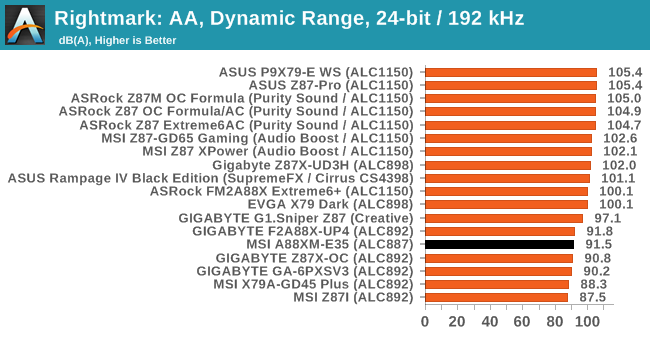
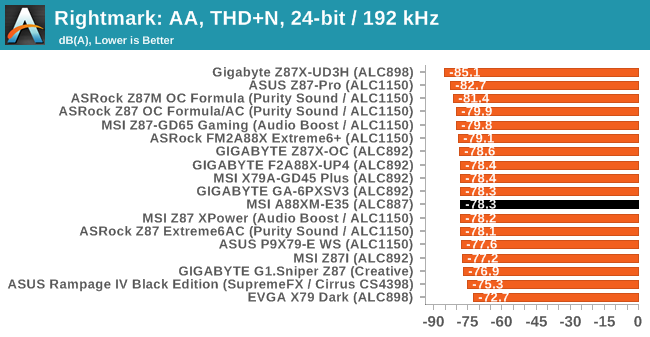
As mentioned in the first page of this review, the ALC887 is a cut down version of the ALC892, offering only 2.1 audio rather than 5.1 or 7.1 while keeping roughly the same dynamic range and distortion.
USB Backup
For this benchmark, we run CrystalDiskMark to determine the ideal sequential read and write speeds for the USB port using our 240 GB OCZ Vertex3 SSD with a SATA 6 Gbps to USB 3.0 converter. Then we transfer a set size of files from the SSD to the USB drive using DiskBench, which monitors the time taken to transfer. The files transferred are a 1.52 GB set of 2867 files across 320 folders – 95% of these files are small typical website files, and the rest (90% of the size) are the videos used in the WinRAR test. In an update to pre-Z87 testing, we also run MaxCPU to load up one of the threads during the test which improves general performance up to 15% by causing all the internal pathways to run at full speed.
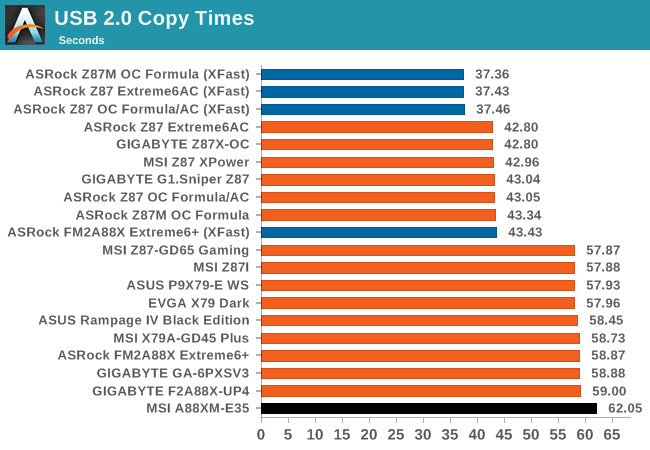
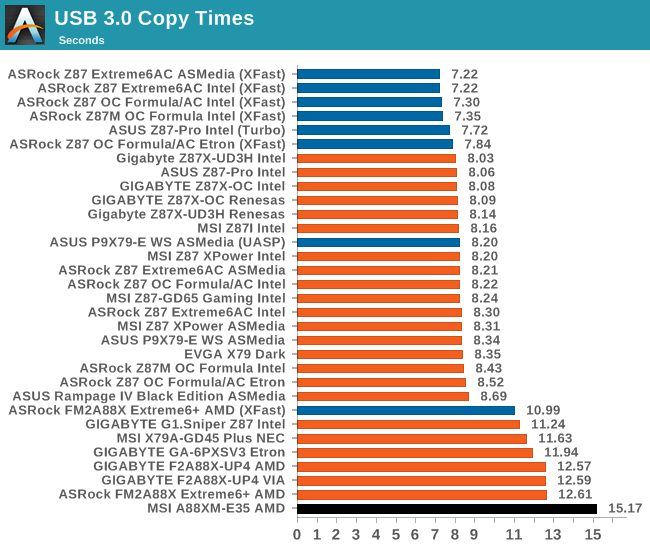
MSI’s USB performance at stock settings has historically been a series of ups and downs. While the A88XM-E35 is not breaking any records soon, it does not stray too far from other motherboard performances. However for significant data transfer there are better options available.
DPC Latency
Deferred Procedure Call latency is a way in which Windows handles interrupt servicing. In order to wait for a processor to acknowledge the request, the system will queue all interrupt requests by priority. Critical interrupts will be handled as soon as possible, whereas lesser priority requests, such as audio, will be further down the line. So if the audio device requires data, it will have to wait until the request is processed before the buffer is filled. If the device drivers of higher priority components in a system are poorly implemented, this can cause delays in request scheduling and process time, resulting in an empty audio buffer – this leads to characteristic audible pauses, pops and clicks. Having a bigger buffer and correctly implemented system drivers obviously helps in this regard. The DPC latency checker measures how much time is processing DPCs from driver invocation – the lower the value will result in better audio transfer at smaller buffer sizes. Results are measured in microseconds and taken as the peak latency while cycling through a series of short HD videos - less than 500 microseconds usually gets the green light, but the lower the better.
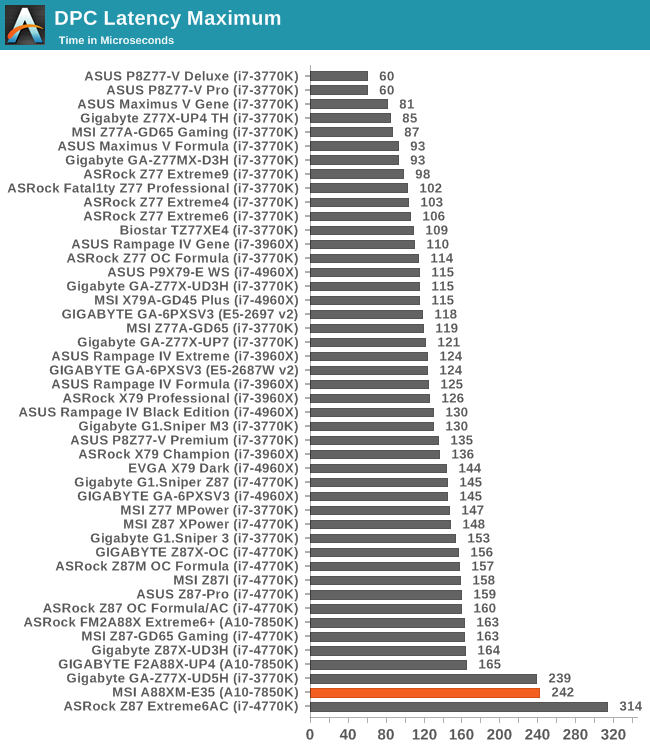
As one might imagine a $63 motherboard is not the best choice when it comes to a DAW. The lack of optimization on the cheaper products in the stack means the A88XM-E35 comes out at 242 microseconds on the DPC Latency test. While for most users this will not feel any different to everyday usage, users that need a sub-150 or sub-100 motherboard will have to look elsewhere.


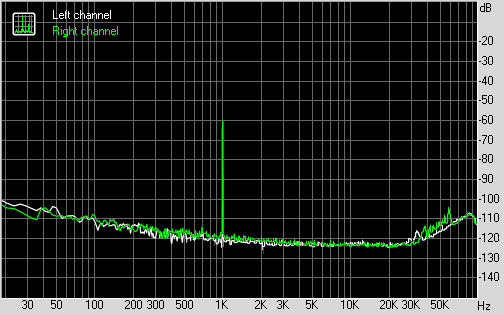








27 Comments
View All Comments
Demiurge - Thursday, April 3, 2014 - link
Good review. I am looking forward to mini-ITX board reviews in the future (hopefully there are some coming)... This is exactly what needs to be analyzed in this class of reviews. This flaw is a good find that an OEM may be aware of, but a retail customer would discover it through a negative experience.Myrandex - Thursday, April 3, 2014 - link
Look into the Gigabyte Mini ITX model. They reviewed it here on Anandtech but I have built a nice SFF system for a customer of mine using that and it was a great experience.Demiurge - Saturday, April 5, 2014 - link
Thanks, Myrandex!extremesheep49 - Thursday, April 3, 2014 - link
Can you elaborate on why this "power delivery" issue would or could happen or post a link to somewhere that discusses the issue? It seems odd to me that replacing a higher power chip (100W Richland) with a lower power chip (65W or 95W Kaveri) would create a heat generation issue.Is it a flaw in the Kaveri chip or just a different design which taxes the motherboard differently? If it's a flaw in the Kaveri design, is it something likely to be fixed by before Carrizo or is just a minor glitch to be fixed by a revision?
I'm just trying to understand the issue you are commenting on.
The_Assimilator - Thursday, April 3, 2014 - link
Considering you can buy a Z77 motherboard with minimal heatsinks on the power delivery circuitry (Z77-D3H comes to mind) that will happily run a 95W Sandy Bridge CPU at a 4GHz overclock without extra cooling, this is very concerning. It sounds to me like either AMD or board manufacturers are cheaping out on power delivery, or AMD has (yet again) engineered a turkey. Would appreciate if AnandTech could investigate and get to the bottom of this.jtd871 - Thursday, April 3, 2014 - link
A few comments:On the Conclusion page, "Performance is consummate with other FM2+..." - the word should probably be "commensurate".
I realize that many will go for the high-end Kaveri APU, but is the power delivery on the current crop of A88X boards really intended (or just better-suited) for the 45W/65W parts instead?
Per the comment on the opening page, I've been thinking about buying/building a Thin-ITX/NUC/Brix-sized system for general home use, and Kaveri (or maybe the next generation) seems to augur well for being able to do this at a modest power (and cooling) budget. Vendors will really have to get the cooling solutions sorted out, though.
lurker22 - Thursday, April 3, 2014 - link
Gotta wonder why Ps2 ports in 2014?sfuzzz - Thursday, April 3, 2014 - link
N-key rolloverFlunk - Thursday, April 3, 2014 - link
I don't think people buying $80 motherboards are generally concerned with USBs 6-key rollover limit seeing as keyboards that support more than 6-key rollover are generally more than $100.Flunk - Thursday, April 3, 2014 - link
The real reason is probably because PS2 ports are cheap and the chipset only supports so many USB ports.